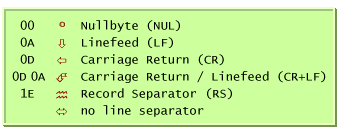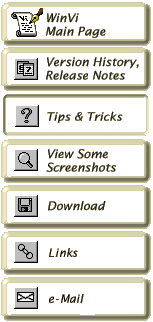|
|
|
- New in version 2.98beta: Converting between different character
encodings (e.g. ANSI codes to UTF-8) can be easily done using the
clipboard: simply select the entire text with
Ctrl+C, change the encoding by clicking the
corresponding toolbar button and finally paste the original text with
Ctrl+V.
- Especially for use with "View source" in the Internet Explorer,
there is a special handling in the 32-bit version of WinVi:
If the first character of the program file name is an N
(as in NWINVI32.EXE),
parameter decoding occurs compatible to Notepad.
In this case, a file name containing spaces need not be surrounded
by double quotes. As a result, it is not possible to specify more
than one file on the command line.
Printing can be done by specifying /p as
the first parameter (instead of -p with
"standard" WinVi). You can use any other file name beginning with N
but you should be sure to have a backup copy when replacing existing
files.
- When using the original program file name, the following might be
interesting for you:
If a double click in Windows Explorer does not correctly open a file
containing spaces in its name, you might have to change the file
association. Append the five characters
<space>"%1"
to the command line of WinVi to tell the Explorer to open the file
with double quotes surrounding the name.
Look for the file type in Explorer's menu "View" -> "Options..."
-> "File types", then click "Edit..." and in the appearing dialog box
click "Edit..." again. Then change the command line from C:\your-path\WinVi32.exe to
C:\your-path\WinVi32.exe "%1" .
- If you use the ex command
:vi <file> instead of
:e <file>, the
specified file will be opened in a new window.
- To see the matched string after searching with
/ or ?
(vi search method), simply push the toolbar button "Search again".
A non-empty character sequence at the current position will be
found again and selected.
- When opening a File, the type of text is determined by counting
the newline characters. If at least one CR/LF sequence is found,
the file is handled as a DOS/Windows file. Otherwise it is Unix
(more LFs than CRs) or Mac format (more CRs).
The status line shows a corresponding file attribute ([Lf] or [Cr]).
When inserting <Enter>,
the corresponding newline will be generated, according to the
text file type. Any other newline will be displayed with a
dark red special symbol as displayed in the table below.
- Following bytes are considered being newlines
(red = display on screen):

The double arrow at the end of the table is used if a line is not
terminated by a special character (currently used at end of file
only).
The regular expressions
/. or
/[^x]
do not match any of these newline characters.
- When reading or writing a file, newline characters are never
converted automatically.
- Newline characters can be included in regular expression
search patterns.
Example: Change a DOS formatted text file to Unix format with
:%s/\%0d\%0a/\%0a/ .
- To alter cursor left, cursor right, and backspace to a line
wrapping behaviour, change the flag
"Line wrapping horizontal cursor movements"
in the Settings dialog.
- Several changes can be undone by successively typing
<Alt+Bksp>.
To redo the last undo operation, you can use the vi compatible
command <Esc> u (undo).
Please note that only the last input of
<Alt+Bksp>
can be reverted.
- After opening another file, you can go back to the previously
edited file by simply typing
Ctrl+^ or
Ctrl+6.
If you type it again, you will move back to the original position
where you first typed this control character.
- You can search for more than one pattern within one regular
expression.
Several "branches" can be combined in one search expression
if you parenthesize the choices (escaped!) and separate them
by an escaped bar.
Example: Typing
/\(first\|second\) branch<Enter>
, you can find the next occurrence of "first branch" or
"second branch".
- Using the clipboard, you can now copy any binary data including
null bytes between two instances of WinVi.
- Within the command line (after input of
:), the current word
at nearly any position can be automatically expanded
when using the tab key. If there is more than one choice, a popup menu
will appear. This feature is especially useful when
browsing for a file path to open.
- The filename in the window title and in the Windows submenu
contains an appended * if the text has changed but
has not been saved yet. The save button in the toolbar is
gray if there are no changes that have not been saved
into the current file.
After undo of initial changes the previous safety state will
be restored.
- You can click and drag any files from Explorer or File Manager
into a running window of WinVi. The first file will be opened
instead of the previous current file. Use
:n<Enter> to switch
to the next dropped file. If you hold down the shift key while
dropping files, a new WinVi window will be created for each file.
- You can search for the word at the current position, in forward
direction with *,
backward with #.
- The contents of the first field of the status line can be put into
the clipboard for further actions. A corresponding menu pops up
with a right mouse button click on this field (or by input
of <Ctrl+Shift+F10>).
|





